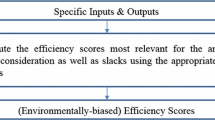Abstract
The dramatic rise in bank failures over the last decade has led to a search for leading indicators so that costly bailouts might be avoided. While the quality of a bank's management is generally acknowledged to be a key contributor to institutional collapse, it is usually excluded from early warning models for lack of a metric. This paper presents a new approach for quantifying a bank's managerial efficiency, using a data-envelopment-analysis model that combines multiple inputs and outputs to compute a scalar measure of efficiency and quality. An analysis of 930 banks over a five-year period shows significant differences in management-quality scores between surviving and failing institutions. These differences are detectable long before failure occurs and increase as the failure date approaches. Hence this new metric provides an important, yet previously missing, modelling element for the early identification of troubled banks.
Similar content being viewed by others
References
T. Ahn, A. Charnes and W.W. Cooper, A note of the efficiency characterizations obtained in different DEA models, Socio-Economic Planning Sci. 22 (1989) 253–257.
T. Ahn and L.M. Seiford, Sensitivity of DEA to models and variable sets in a hypothesis test setting: The efficiency of university operations, in:Creative and Innovative Approaches to the Science of Management, ed. Yuji Ijiri (1992), to appear.
I. Ali and L.M. Seiford, The mathematical programming approach to efficiency measurement, in:The Measurement of Productive Efficiency: Techniques and Applications, eds. H. Fried, K. Lovell and S. Schmidt (Oxford University Press, 1992).
I. Ali, A. Bessent, W. Bessent and J. Kennington, Data envelopment analysis of the efficiency to decision making units with the DEA3 code (Version 3.0), Research Report CCS 410, Center for Cybernetic Studies, The University of Texas (July 1981).
R.S. Barr and T.F. Siems, Predicting bank failure using DEA to quantify management quality, Research Paper, Federal Reserve Bank of Dallas (1991).
S.A. Berg, F.R. Forsund and E.S. Jansen, Bank output measurement and the construction of best practice frontiers, Research Report, Bank of Norway (July 1989).
A. Charnes, W.W. Cooper and E. Rhodes, Measuring the efficiency of decision making units, Euro. J. Oper. Res. 2 (1978) 429–444.
F.C. Graham and J.E. Horner, Bank failure: An evaluation of factors contributing to the failure of national banks, Issues in Bank Regulation 12 (1988) 8–12.
G.A. Hanweck, Predicting bank failure, Research Paper in Banking and Financial Economics, Financial Studies Section, Division of Research and Statistics, Board of Governors of the Federal Reserve System (November 1977).
J. Kennington, A primal simplex code for computing the efficiency of decision making units, Technical Report OREM 80001, Department of Operations Research, Southern Methodist University, Dallas, Texas (1980).
D. Martin, Early warning of bank failure: A logic regression approach, J. Banking Fin. 1 (1977) 249–276.
P.A. Meyer and H.W. Pifer, Prediction of bank failures, J. Fin. 25 (1970) 853–868.
C.C. Pantalone and M.B. Platt, Predicting commercial bank failure since deregulation, New England Econ. Rev. (Jul/Aug 1987) 37–47.
C. Parkan, Measuring the efficiency of service operations: An application to bank brnches, Eng. Costs Prod. Econ. (1987) 237–242.
N. Rangan, R. Grabowski, H.Y. Aly and C. Pasurka, The technical efficiency of US banks, Econ. Lett. 28 (1988) 169–175.
L.D. Seballos and J.B. Thomson, Understanding causes of commercial bank failures in the 1980s, Econ. Comm., Federal Reserve Board of Cleveland (September 1990).
H. Secrist,National Bank Failures and Non-Failures: An Autopsy and Diagnosis (Principia Press, Bloomington, IN, 1938).
L.M. Seiford, A bibliography of data envelopment analysis (1978–1990), Version 5.0 (April 1990), Technical Report, Dept. of IEOR, U. of Massachusetts, Amherst, MA 01003, USA.
L.M. Seiford and R.M. Thrall, Recent developments in DEA: The mathematical programming approach to frontier analysis, J. Econometrics 46 (1990) 7–38.
T.R. Sexton, The methodology of data envelopment analysis, in:Measuring Efficiency: An Assessment of Data Envelopment Analysis, ed. R.H. Silkman (Jossey-Bass, San Francisco, CA, 1986).
H.D. Sherman and F. Gold, Bank branch operating efficiency: Evaluation with data envelopment analysis, J. Banking Fin. 9 (1985) 297–315.
T.F. Siems, An envelopment-analysis approach to measuring management quality and predicting failure of banks, Ph.D. Dissertation, Southern Methodist University (1991).
T.F. Siems, Quantifying Management's role in bank survival, Econ. Rev., Federal Reserve Bank of Dallas (First Quarter, 1992).
J.F. Sinkey, Jr., A multivariate statistical analysis of the characteristics of problem banks, J. Fin. 30 (1975) 21–36.
J.F. Sinkey, Jr., Identifying large problem/failed banks: Case of Franklin National Bank of New York, J. Fin. Quantit. Anal. 12 (1977) 779–800.
J.F. Sinkey, Jr., Identifying problem banks: How do banking authorities measure a bank's risk exposure?, J. Money, Credit, and Banking 10 (1978) 184–193.
D.L. Thomas, Auditing the efficiency of regulated companies through the use of data envelopment analysis: An application to electric cooperatives, Ph.D. Thesis, The University of Texas, Graduate School of Business, Austin, Texas (1985).
R.M. Thrall, Classification transitions under expansions of inputs and outputs in data envelopment analysis, Manag. Dec. Econ. 10 (1989) 159–162.
R.C. West, A factor-analytic approach to bank condition, J. Banking Fin. 9 (1985) 253–266.
Author information
Authors and Affiliations
Rights and permissions
About this article
Cite this article
Barr, R.S., Seiford, L.M. & Siems, T.F. An envelopment-analysis approach to measuring the managerial efficiency of banks. Ann Oper Res 45, 1–19 (1993). https://doi.org/10.1007/BF02282039
Issue Date:
DOI: https://doi.org/10.1007/BF02282039




